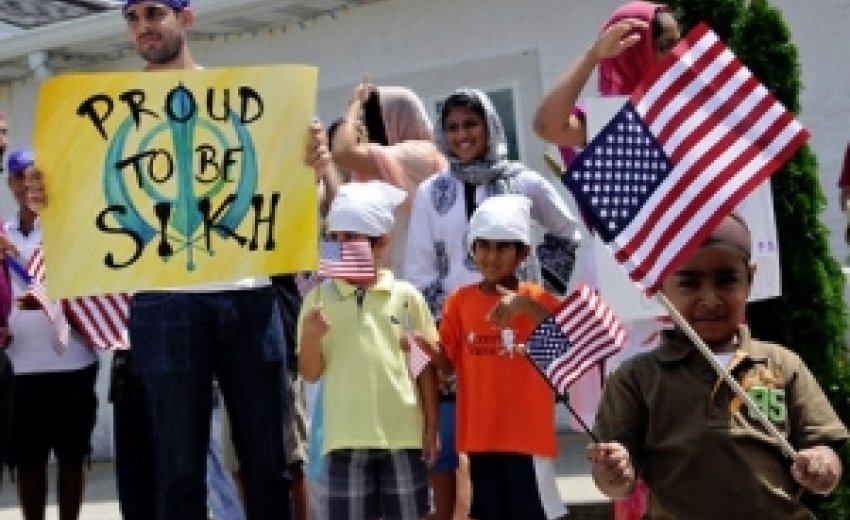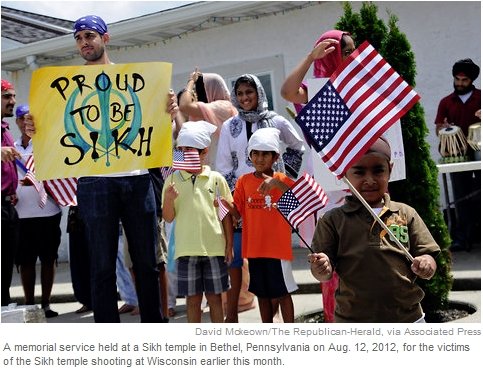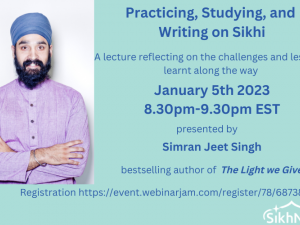|
DO American Sikhs count?
The horrific shooting at a Sikh temple in suburban Milwaukee on Aug. 5, in which a white supremacist, Wade M. Page, killed six people before fatally shooting himself, elicited an outpouring of sympathy from American leaders and a greater understanding of the role Sikhs have played in American life. But there are two disturbing aspects of the response to the shooting that deserve wider public attention. First is the notion of “mistaken identity” — the assumption that Mr. Page, who had long-established ties to radical right-wing groups, mistook Sikhs for Muslims, his presumed target. The second is the government’s failure to accurately measure the extent of anti-Sikh violence in America — a gap that must be remedied. Whatever the roots of Mr. Page’s hatred, it is wrong to assume that every attack against a Sikh is really meant for a Muslim. That assumption overlooks the long history of discrimination and hatred directed at Sikhs in America Indeed, the first documented race riot targeting American Sikhs occurred in 1907 in Bellingham, Wash. Their distinct religious identity (uncut hair, turban, beard) has historically marked Sikhs, particularly men, as targets for discrimination, both in their homeland in South Asia and in the various communities of the Sikh diaspora. And of course, 9/11 brought about a surge in fear and persecution directed at Sikhs, Muslims and other minorities with ties to the Middle East and South Asia. There is also the question of whether white supremacist groups have specifically targeted American Sikhs. The authorities in Southern California, where Mr. Page was active in the white-power music scene, are investigating whether he was involved in the killings of two elderly Sikh men in Elk Grove, Calif., in March 2011. Just after the temple shooting, a Sikh man in Oak Creek, Wis., reported that a white man had pulled up next to him in a pickup truck, shaped his hands like a gun, and pretended to shoot him six times before stating, “We want to kill all of you.” And on Aug. 15, 10 days after the Oak Creek shooting, another member of the Sikh community there, Dalbir Singh, 56, was killed in the armed robbery of a local convenience store. (While the police have not uncovered any evidence to treat the killing as a hate crime, many Sikhs have wondered if the violence was more than random.) White supremacist Web sites clearly demonstrate intentional, targeted anti-Sikh sentiments. For example, the leading neo-Nazi figure Alex Linder was quoted as saying on a right-wing Web site: “Take your dead and go back to India and dump their ashes in the Ganges, Sikhs. You don’t belong here in the country my ancestors fought to found, and deeded to me and mine, their posterity. Even if you came here legally, and even if you haven’t done anything wrong personally. Go home, Sikhs. Go home to India where you belong. This is not your country, it belongs to white men.” The “mistaken identity” assumption is directly associated with a second problem: a lack of data about the extent of anti-Sikh hatred. The F.B.I. currently classifies nearly all hate violence against American Sikhs as instances of anti-Islamic or anti-Muslim hate crimes. As a result, we do not have official statistics on the extent of hate crimes in which Sikhs are targeted, despite a long history of such violence. Why is this so? The F.B.I. tracks hate crimes on the basis of bias motivation, even if the victim is not part of the group that was targeted. The official Hate Crime Incident Report allows authorities to register a hate crime under one of five categories: race, ethnicity (including Hispanic identity), religion, sexual orientation or disability. Within those five categories are 22 subcategories, none of them designated “anti-Sikh.” Thus the F.B.I. classifies anti-Sikh crimes as “anti-Islamic (Muslim).” We call on the F.B.I. to begin tracking anti-Sikh violence. This does not require legislation or executive order. Since the original enactment of the Hate Crime Statistics Act of 1990, the F.B.I. has updated its reporting methods. For example, the bureau has revised its approach to tracking hate crimes based on sexual orientation, and now includes “anti-L.G.B.T.,” “anti-heterosexual” and “anti-bisexual” along with the “anti-gay” and “anti-lesbian” subcategories. The legacy of anti-Sikh violence and its contemporary prevalence make it painfully obvious that anti-Sikh violence is often purposeful and targeted. The government must begin tracking and counting anti-Sikh hate crimes, just as it must continue to vigorously combat bias and discrimination against all Americans, including Muslims. We must do away with a flawed and incomplete assumption of “mistaken identity” regarding Sikhs; until we do, we will all be the ones who are mistaken. Simran Jeet Singh is a doctoral candidate in religion at Columbia and the deputy director of the Sikh Spirit Foundation. Prabhjot Singh is an assistant professor of international and public affairs at Columbia and a resident in internal medicine at Mount Sinai Hospital. |







